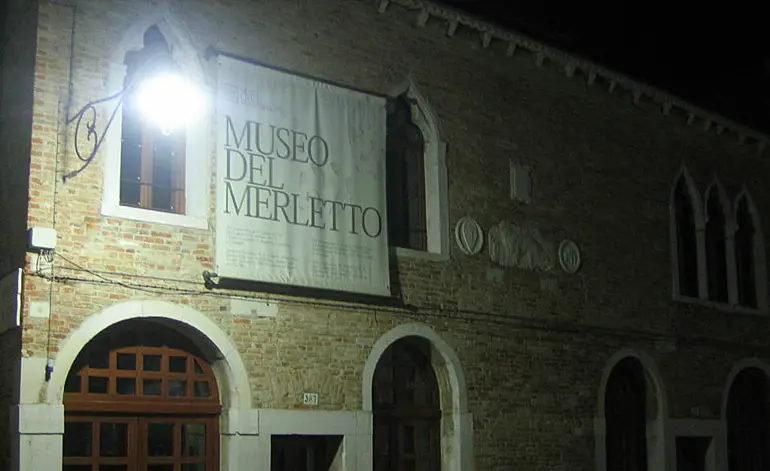| In Venice Today.com |
|
||
|
|
|||||||||||||||||||||||||||||||||||
|
|||||||||||||||||
Lace Museum in Burano, Venice ItalyThe Lace Museum in Burano, island of Venice Lagoon: history, opening hours, contacts, fares of tickets and useful information for the visit. |
|||||||||||||||||
|
|||||||||||||||||
|
|||||||||||||||||
 Lace Museum - Burano Island, Piazza Baldassarre Galuppi, 187 - Venice The Lace Museum in Burano is housed in the Scuola dei Merletti open since 1872 by the will of Countess Andriana Marcello. The Museum is part of the circuit of the Venetian Civic Museums and occasionally organizes exhibitions during the year.  The museum itinerary exhibits more than two hundred copies that once belonged to the historic School of Lace but also gives the opportunity to visually appreciate the technique of making the famous Burano lace; in fact, every morning the lace-makers still active in the lagoon are present in the museum, giving the visitor a real taste of what is the refined processing technique of this precious artifact. The Lace Museum also houses exhibits dating from the 16th to the 20th century, all of original Venetian workmanship, and an archive that remains available to scholars, rich in historical documentation, with drawings and photographs from various eras. The itinerary, arranged on two floors, consists in addition to the findings of didactic information and multimedia materials to complete a path full of charm and at least original for the visitor who chooses for a stop also the Museum of Lace of Burano among the museums present in the lagoon. So the visitor, through four rooms full of finds on the first floor, can travel through time knowing the influence of this art on the costumes and fashions, on the economy and on the history of Venice and its islands; a history that in certain eras, especially in the seventeenth century, became European because the lace of Burano was at the time in vogue in all the European courts and not only, so as to be copied in France to the court of the Sun King in a given historical period. The rooms on the upper floor are organized according to a chronological path that covers a period of time that goes from the eleventh century, when the lace still had strong Byzantine influences ie Aegean, until the crisis that this art experienced at the end of the nineteenth century and in the course of the twentieth century, characterized by efforts to preserve its rites and techniques. At each epoch its point: if in the primordial hypothesis the use of Byzantine point bibila, already in the sixteenth century there are many points that are simultaneously used to make the laces that adorn the clothes of the aristocrats everywhere. In this period, moreover, with the birth of the press, there are many editions of models, that is, drawings for laces and embroidery printed by the printers of the time. But it is in the seventeenth century, with the use of the Venice point cut high-relief foliage, that the lagoon lace explodes commercially, reaching challenging costs even for the rich aristocrats of the European courtesan society. A phenomenon of custom able to incorporate the artistic trends of the time: during the Baroque including plant and animal species and later oriental motifs coming from India. Of the eighteenth century is the birth of the Burano point that characterized the production for the last period in which this could be called such, before the nineteenth century, the inexorable decline of lace, due much to the cultural change brought by the French Revolution, the birth of bourgeoisie and the modern world. History It was Countess Andriana Marcello who wanted to open the Scuola dei Merletti in Burano; because a wealth of knowledge that had such historical and technical importance was not dissipated forever. Closed the school in the twentieth century was the foundation dedicated to the countess and public and political commitment to save the art of lace from oblivion to which it was destined with the opening of the museum and the direct conivolation of the few lace-makers still active on the island of Burano. The Lace Museum therefore became part of the circuit of the Venetian Civic Museums from 1995, thus ensuring a place in the Venice lagoon cultural itinerary. How to get to Lace Museum - From Piazzale Roma take Line 41 and get off at the Fondamente Nove stop. Here change with the Burano line. - From Venezia Santa Lucia Train Station take Line 41 and get off at Fondamente Nove. Here change with the Burano line. - From Lido di Venezia take Line 51 to the Fondamenta Nuove stop, then change to the Burano line. Watch the Video by Venice Civic Museums of Lace Museum
|
|||||||||||||||||
| Hours: from November 1st to March 31st from 10.00am to 5.00pm (ticket office from 10.00am to 4.30pm). From 1 April to 31 October from 10.00 to 18.00 (ticket office from 10.00 to 17.30). Closed on Monday, December 25th, January 1st and May 1st.
Tickets: full � 5 euros; reduced � 3.50 (children from 6 to 14 years, students from 15 to 25 years, chaperones of groups of boys or students (up to 2), citizens over 65, staff of the Ministry of Cultural Heritage and Activities and Tourism (MiBACT); Rolling Venice Card holders, FAI members). Free for residents and born in the City of Venice; children from 0 to 5 years; I.C.O.M. members; handicapped people with a companion; licensed guides and tourist interpreters accompanying groups or individual visitors; for each group of at least 15 people, 1 free entry (only with reservation); ordinary MUVE partners; MUVE Friend Card holders. Accessibility: completely accessible to the disabled. Information and reservations: info@fmcvenezia.it; call center 848082000 (from Italy); the service is available from Monday to Friday from 9:00 am to 1:00 pm and from 2:00 pm to 6:00 pm; Saturday from 9.00 to 14.00; closed on festive days. |
|||||||||||||||||